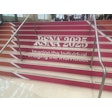Farida Razvi was facing a dilemma. As manager of the nuclear medicine department at Mount Sinai Hospital in Chicago, she wanted to replace the hospital's aging single-head gamma camera, a Prism system of Picker International vintage. But as a nonprofit community hospital, Mount Sinai faced serious budget constraints in terms of how much money it could commit to acquiring new technology.
The solution? Refurbished equipment. By purchasing a preowned system, Razvi was able to upgrade Mount Sinai with a dual-head variable-angle gamma camera at a significant discount to what a new unit might cost. Mount Sinai purchased the system from a multimodality OEM, and the unit came with a one-year warranty identical to that available on new systems, giving Razvi peace of mind about her purchase.
Razvi said the new system has enabled the department to double its throughput, and Mount Sinai is now looking at expanding its activities in molecular imaging by acquiring a PET/CT scanner for the first time -- also a refurbished system.
A changing market
Mount Sinai's example illustrates the changing face of the refurbished equipment market. Once dominated by mom-and-pop companies, refurbished equipment once carried a whiff of disfavor colored by horror stories of "spray-and-pray" outfits that foisted barely functioning equipment on unsuspecting customers.
How times have changed. The major multimodality OEMs have taken a page from the auto industry, setting up programs in which they take equipment on trade-in, have it refurbished and updated, then sell it packaged with warranties designed to protect their customer's investment. At the same time, independent refurbishing companies are seeking to burnish the industry's image through self-policing programs.
The growth in refurbished equipment is aided by the rapid replacement cycle in medical imaging, in which technology that was considered state-of-the-art just a few years ago is frequently jettisoned by sites that must have the latest and greatest. Going the refurbished route can be a great deal for those who don't have to be on the bleeding edge, with preowned equipment costing 30% to 50% less than brand-new systems.
According to Diana Upton, president of the International Association of Medical Equipment Remarketers and Servicers (IAMERS), preowned equipment can be broadly categorized into two main segments: equipment sold under OEM warranty plans and equipment sold on an "as is, where is" basis from an equipment broker. Brokers specialize in using their industry contacts to match sites that want to sell an older piece of equipment with other facilities looking for preowned systems.
Many of these equipment brokers are small mom-and-pop outfits, and there remains an element of "caveat emptor" for those looking to purchase preowned systems through independent firms. Still, buyers who do their homework and are diligent about researching their purchase can be rewarded with good deals.
"The 'as-is, where is' market is viable for some folks, and you can get equipment that is very good if you know what you're doing," Upton said.
IAMERS was formed in 1993 to provide a means for independent equipment brokers to police themselves. The group charges $700 for an annual membership, and provides a dispute-resolution mechanism for buyers who feel they got a raw deal. Brokers can be thrown out of the association if they're found to be conducting business in an unethical manner. Some 110 companies are members of IAMERS, including a few large OEMs that operate their own refurbishing businesses.
The OEMs get interested
The entry of the OEMs represents an interesting new wrinkle to the refurbished equipment business that's developed in just the last few years. Large multimodality vendors have set up their own programs to accept equipment on trade-in and process it through their own facilities or through third-party refurbishers. The equipment is then certified by the OEM and carries a warranty of up to one year -- just like what's available on new equipment (see sidebar, "The OEM refurbishing process").

"I truly feel that I have a brand-new piece of equipment at probably 50% of the price."
-- Dr. Mark Lopiano,
Medical Director,
Medical Imaging Center of Fairfax
Fairfax, VA
Competition for imaging services in the region is fierce, Lopiano said, and the facility was having trouble generating much volume for its CT service -- probably because the system was an outdated single-slice model. Due to its low CT volume, InSight management suggested the site acquire a refurbished rather than new system, and Lopiano last year began examining a 16-slice system under an OEM warranty program.
Lopiano soon found there's a lot to like about buying refurbished equipment. In addition to a one-year warranty, Lopiano was able to ask the vendor to make a number of enhancements to the system during the refurbishing process, such as the addition of a more powerful x-ray tube that isn't commonly available on a 16-slice scanner. That gives Lopiano's scanner a faster rotation time and achieves more body coverage without generating more heat units. Lopiano also negotiated to get a workstation with the latest software for performing advanced applications.
"If the vendor is going to refurbish (the scanner) anyway, they can pull the standard tube and put in a higher tube, or a new generator. They can put the latest software on it," Lopiano said. "I truly feel that I have a brand-new piece of equipment at probably 50% of the price."
Like Lopiano, Razvi at Mount Sinai also requested modifications to the dual-head gamma camera that her facility purchased, including a new crystal and new workstation software.
"The crystal is the important part, and that was new. That is basically what you want," Razvi said. "We had all the latest software of whatever we were doing on the processing side."
What can you get?
Much of what's available on the preowned equipment market varies based on modality. Some technologies, such as CT, have seen rapid advances recently, and as a result it's easier to get technology that was state-of-the-art just a few years ago.
In molecular imaging, there's little market anymore for dedicated PET systems, as hybrid PET/CT units have taken over this segment. In addition, some brands, particularly those of the larger multimodality OEMs, tend to hold their value versus lesser known marques, Upton said.
Protecting yourself
What's the best way to make sure you don't get a lemon when buying refurbished equipment? If you purchase through an independent broker, first make sure the broker is a member of IAMERS in good standing, Upton said. Then make sure you perform a comprehensive site inspection of the equipment you're buying.
In most cases, this inspection shouldn't necessarily be conducted by a radiologist, but rather by someone who is familiar with the technology. In particular, try to inspect the equipment while it is still installed and running at the previous owner's facility, she advised.
One common misunderstanding that Upton runs into regards buyers who aren't exactly clear on what's included in the package of equipment they are purchasing. For example, is the chiller used with an MRI scanner included in the deal, or does the hospital consider it a part of its facility that it is going to retain? If there is a second workstation used with the system, will that workstation be included? Make sure that everything you're expecting to get is specified in the contract, Upton advises.
Both Razvi and Lopiano, who purchased their refurbished systems under OEM programs, said they felt comfortable enough with the vendor warranties that they didn't need to conduct system inspections. Both, however, advised those who are buying through OEM programs to take advantage of the chance to customize their systems.
Both say that purchasing refurbished equipment helped them modernize their facility, increase throughput, and make their services more competitive. At Mount Sinai, the nuclear medicine department doubled its throughput, which has laid the groundwork for starting a PET/CT service, Razvi said.
Lopiano feels that, at least in his case, the concerns about refurbished equipment are a thing of the past.
"Don't worry about looking at refurbished equipment if you stay with a reputable vendor," Lopiano said. "I felt very comfortable going with a big company."
By Brian Casey
AuntMinnie.com staff writer
March 1, 2007
Copyright © 2007 AuntMinnie.com



















